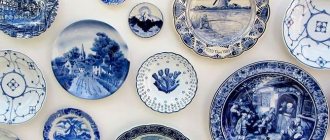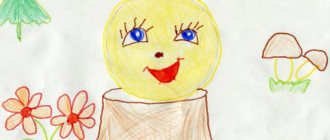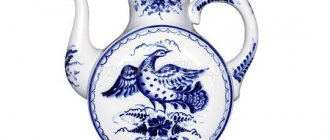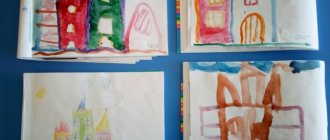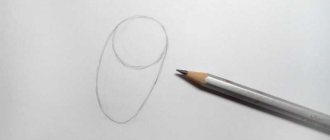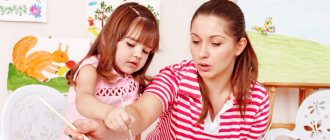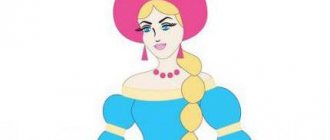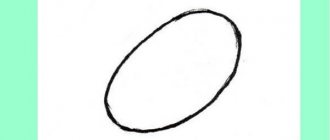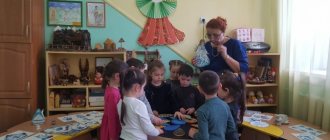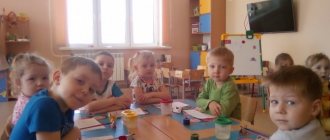Summary of visual activities in the preparatory group “Russian Matryoshka”
Prokopets Natalya
Summary of visual activities in the preparatory group “Russian Matryoshka”
summary of visual activities in the preparatory group
theme: “Russian nesting doll”
Integration of educational areas:
1. Cognitive development
2. Artistic and aesthetic development
3. Physical development
Types of visual activities: drawing
Preliminary work: examining images of different types of nesting dolls, drawing children’s attention to the painting of nesting dolls, features of the use of colors; drawing patterns, drawing nesting dolls in my free time.
Handout: ready-made outlines of nesting dolls, colored pencils.
Demonstration: A sample of the finished nesting doll and colored pencils, drawings depicting nesting dolls, wooden nesting dolls.
Educational: Introduce children to different types of nesting dolls (Semenovskaya, Sergievskaya, Polkhov-Maidanovskaya).
Simple drawing with felt-tip pens
A matryoshka doll (a drawing for children does not have to be completely filled in with a felt-tip pen) can be drawn with dashes of different lengths, dots, and squiggles.
The result will be a more accurate picture.
- Use a black felt-tip pen to draw a circle as evenly as possible.
- Below, on the outside of the circle, draw a knot and a bow.
- Draw hair inside the circle: 2 arcs, starting from one top point and ending on different sides of the circle.
- Draw 2 eyes in the central part of the head, and a smile just below.
Draw a big eight like this:
- Draw a semicircle above your head, 1 cm from it.
- Draw a second arc at the bottom of the sheet. Its size must be larger than the first arc.
- Connect the left edge of the upper arc with the left edge of the lower arc with a line curved inward.
- Connect the right edge of the upper arc with the right edge of the lower arc with a line curved inward.
This will create a toy figure.
Further:
- Draw smooth lines that form the edge of the scarf.
- Draw an apron, the upper part of which rests on the scarf.
- Draw hands on the sides of the matryoshka (between the apron and the edge of the toy). The sleeve line begins where the scarf ends and is formed from a small rectangle.
- Draw a flower in the center of the apron.
To color the sketch, you need to take felt-tip pens in the following shades: yellow, orange, beige, light and dark brown, green and red:
- Use a yellow marker to color the apron.
- Use an orange felt-tip pen to color the lower part of the nesting doll (dress).
- In order to paint your face, you need to choose a shade of flesh color.
- Use a light brown felt-tip pen to color your hair. Then take a dark brown felt-tip pen and draw several stripes through your hair to create shimmer.
- Color the scarf green.
- Color the flower on the apron red.
- Put red dots on the dress.
- Draw a spiral pattern on the apron in orange, bordering the apron in a circle.
- Color your hands with a flesh-colored felt-tip pen.
Simple drawing
To draw a simple drawing with your child, you need to follow several steps:
- Draw an egg with a blunt base.
- Draw a narrow stand on the base.
- At the top of the resulting oval, draw a circle for the face and bangs.
- Draw a face: eyes, nose, cheeks, smile and hair.
- Draw arms on both sides of the body.
To put on a matryoshka doll, you need:
- Draw 2 smooth lines under the circle of the face from the center to the sides. You will get a scarf.
- Draw the knot and ends of the scarf.
- At the bottom of the figure, draw the hem of the sundress.
- Draw any pattern on the apron: flower, berries, circles, and so on.
On the topic: methodological developments, presentations and notes
Summary of a lesson on familiarizing children with their surroundings. Topic: “Toys. Getting to know the Russian nesting doll" - from a series of integrated lessons on the topic: "Matryoshka".
The activity will help introduce children to the folk toy - matryoshka. Integration of educational areas: "Cognition", "Artistic creativity", "Communication", "Music".
Long term project. For preschool teachers.
Application for the middle group of kindergarten, from the “Our Motherland” section.
Program content: Educational objectives: Tell about the most popular folk wooden toy, nesting dolls. Teach children to distinguish between different techniques for painting nesting dolls. Develop children's creative imagination.
Introduction to Russian folk culture should be introduced from early childhood.
Source
Progress of continuous educational activities.
A teacher in Russian costume greets the children.
Educator. Come on in, guys! to see you , come in. (Gathers children around him)
.
Guys, would you like to be in a fairy tale ? (Answer)
.
To get there, you need to dress up: girls wear sundresses and scarves, and boys wear caps decorated with flowers. You are now beautiful girls and good fellows. And I will turn into a storyteller . So, 1, 2, 3 - turn around, you will find yourself in a fairy tale !
Educator. I, a storyteller , know a lot of fairy tales . turn any fairy tale Do you want to listen to my unusual fairy tale ? Sit down more comfortably. (Children sit on chairs)
.
What tale should I tell you ? (Looks through the reader)
.
I found it. You probably don't know this one. Guess the fairy tale , listen to the riddle:
Masha went into the forest with a basket.
I got a little lost there.
I came across a hut, ate some porridge, and went to bed.
And the owners of the food turned out to be... (Three Bears)
.
Children: yes, we know this fairy tale ! What's unusual here?
Educator: You may know the fairy tale... . But we will read it in a special way! that’s who will tell us this !
Different toys of different heights,
But they look alike
They all sit next to each other,
And just one toy! (Matryoshka)
Educator. You guessed it, well done! They will tell us the tale “The Three Bears”
nesting dolls, listen.
Many wooden, round-faced and ruddy dolls
They live on our table - everyone is called nesting dolls.
This toy comes with a surprise...
Each beautiful nesting doll has a smaller sister hidden in it, and how bright and elegant they are!
Since ancient times, the nesting doll in Rus' was considered a symbol of fertility, wealth and abundance. The matryoshka was a kind of amulet for the family - the keeper of the hearth. It was carved from wood, and then painted and “dressed”
in sundresses, scarves.
Russians loved this toy. Each matryoshka master has his own face, his own outfit and his own character. And each nesting doll with its smile warms the souls of people, gives them warmth and, as it were, reminds them that they should not forget all Russian traditions, customs, and holidays.
Educator. Here are the nesting dolls. Let's look at them, take one nesting doll.
— What patterns do artists decorate matryoshka aprons with?
— what color paints are used?
— What mood are the dolls in?
Educator. That's right, guys, the pattern consists of bright flowers, leaves, and berries. First, the artist draws the contours of the pattern elements with black ink and only after that begins to work with paints - red, green, yellow, blue, violet.
Educator. Guys, now you, beautiful girls and good fellows, will become artists and paint the nesting dolls yourself (children sit at the tables)
.
But not beautiful girls, but heroes of the fairy tale “The Three Bears”
.
Look, in front of you are templates of nesting dolls of different sizes - large, smaller, even smaller, etc. I suggest you join teams of 5 people. Each of you will portray one of the heroes of the fairy tale in the form of a matryoshka doll !
Choose your matryoshka base. Russian folk music is playing, children are working.
At the end, the children gather all the matryoshka heroes together, tell a fairy tale , find the most elegant, most beautiful, most cheerful, brightest matryoshka doll - the hero of the fairy tale .
Source
